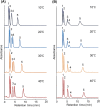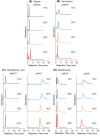Temperature responsive chromatography for therapeutic drug monitoring with an aqueous mobile phase
- PMID: 34873248
- PMCID: PMC8648775
- DOI: 10.1038/s41598-021-02998-2
Temperature responsive chromatography for therapeutic drug monitoring with an aqueous mobile phase
Abstract
Therapeutic drug monitoring is a key technology for effective pharmacological treatment. In the present study, a temperature-responsive chromatography column was developed for safe and simple therapeutic drug monitoring without the use of organic solvents. Poly(N-isopropylacrylamide) (PNIPAAm) hydrogel-modified silica beads were prepared via a condensation reaction and radical polymerization. The temperature-dependent elution behavior of the drugs was observed using a PNIPAAm-modified silica-bead packed column and an all-aqueous mobile phase. Sharp peaks with reproducible retention times were observed at temperatures of 30 °C or 40 °C because the PNIPAAm hydrogel on the silica beads shrinks at these temperatures, limiting drug diffusion into the PNIPAAm hydrogel layer. The elution behavior of the sample from the prepared column was examined using a mixture of serum and model drugs. The serum and drugs were separated on the column at 30 °C or 40 °C, and the concentration of the eluted drug was obtained using the calibration curve. The results show that the prepared chromatography column would be useful for therapeutic drug monitoring because the drug concentration in serum can be measured without using organic solvents in the mobile phase and without any need for sample preparation.
© 2021. The Author(s).
Conflict of interest statement
The authors declare no competing interests.
Figures








Similar articles
-
Bioanalytical technologies using temperature-responsive polymers.Anal Sci. 2024 May;40(5):827-841. doi: 10.1007/s44211-024-00545-3. Epub 2024 Apr 7. Anal Sci. 2024. PMID: 38584205 Free PMC article. Review.
-
Chromatography columns packed with thermoresponsive-cationic-polymer-modified beads for therapeutic drug monitoring.Sci Rep. 2022 Jul 27;12(1):12847. doi: 10.1038/s41598-022-16928-3. Sci Rep. 2022. PMID: 35896711 Free PMC article.
-
Therapeutic Drug Monitoring Using a Poly(N-isopropylacrylamide) Hydrogel-Modified Bead-Packed Column with an All-Aqueous Mobile Phase without Sample Deproteinization.Chem Pharm Bull (Tokyo). 2025;73(9):819-827. doi: 10.1248/cpb.c25-00322. Chem Pharm Bull (Tokyo). 2025. PMID: 40930815
-
Two-dimensional temperature-responsive chromatography using a poly(N-isopropylacrylamide) brush-modified stationary phase for effective therapeutic drug monitoring.Sci Rep. 2022 Feb 16;12(1):2653. doi: 10.1038/s41598-022-06638-1. Sci Rep. 2022. PMID: 35173260 Free PMC article.
-
Aqueous chromatography system using temperature-responsive polymer-modified stationary phases.J Sep Sci. 2006 Apr;29(6):738-49. doi: 10.1002/jssc.200500485. J Sep Sci. 2006. PMID: 16830486 Review.
Cited by
-
Functional aligned mesenchymal stem cell sheets fabricated using micropatterned thermo-responsive cell culture surfaces.Mater Today Bio. 2025 Mar 10;32:101657. doi: 10.1016/j.mtbio.2025.101657. eCollection 2025 Jun. Mater Today Bio. 2025. PMID: 40166377 Free PMC article.
-
Temperature-modulated separation of therapeutic cells, viral vectors, and exosomes using functional polymers.Anal Sci. 2025 Aug;41(8):1251-1267. doi: 10.1007/s44211-025-00785-x. Epub 2025 May 23. Anal Sci. 2025. PMID: 40408001 Free PMC article. Review.
-
Bioanalytical technologies using temperature-responsive polymers.Anal Sci. 2024 May;40(5):827-841. doi: 10.1007/s44211-024-00545-3. Epub 2024 Apr 7. Anal Sci. 2024. PMID: 38584205 Free PMC article. Review.
-
Chromatography columns packed with thermoresponsive-cationic-polymer-modified beads for therapeutic drug monitoring.Sci Rep. 2022 Jul 27;12(1):12847. doi: 10.1038/s41598-022-16928-3. Sci Rep. 2022. PMID: 35896711 Free PMC article.
-
Temperature-responsive mixed-mode column for the modulation of multiple interactions.Sci Rep. 2022 Mar 15;12(1):4434. doi: 10.1038/s41598-022-08475-8. Sci Rep. 2022. PMID: 35292748 Free PMC article.
References
Publication types
LinkOut - more resources
Full Text Sources

